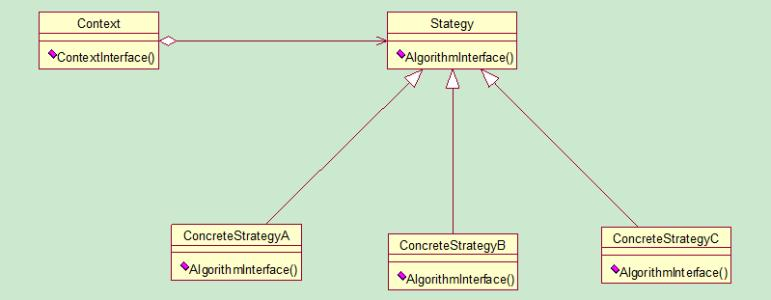策略模式
1.策略模式: 它定义了算法家族,分别封装起来,让他们之间可以互相替换,此模式让算法的变化,不会影响到使用算法的客户.
2. uml类图

3. 优点:
(1)策略模式是一种定义一系列算法的方法,从概念上来看,所有这些算法完成的都是相同的工作,只是实现不同,它可以以相同的方式调用所有的算法,减少了各种算法类与使用算法类之间的耦合.
(2)策略模式的Strategy类层次为Context定义了一系列的可供重用的算法或行为,继承有助于析取出这些算法中的公共功能.
(3)策略模式的优点是简化了单元测试,因为每个算法都有自己的类,可以通过自己的接口单独测试.
4. 缺点:
1、客户端必须知道所有的策略类,并自行决定使用哪一个策略类。这就意味着客户端必须理解这些算法的区别,以便适时选择恰当的算法类。换言之,策略模式只适用于客户端知道所有的算法或行为的情况。
2、 策略模式造成很多的策略类,每个具体策略类都会产生一个新类。有时候可以通过把依赖于环境的状态保存到客户端里面,而将策略类设计成可共享的,这样策略类实例可以被不同客户端使用。换言之,可以使用享元模式来减少对象的数量。
5. 使用场景: 只要在分析过程中听到需要在不同时间应用不同的业务规则,就可以考虑使用策略模式处理这种变化的可能性.
具体实现:
1 package strategy.strategy;
2
3 /**
4 * @author liuboren
5 * @Title:抽象算法类
6 * @Description:
7 * @date 2018/5/30 14:52
8 */
9 public abstract class Strategy {
10
11 //算法方法
12 public abstract void algorithmInterface();
13
14 }
1 package strategy.strategy.impl;
2
3 import strategy.strategy.Strategy;
4
5 /**
6 * @author liuboren
7 * @Title:具体算法类A
8 * @Description:
9 * @date 2018/5/30 14:53
10 */
11 public class ConcreteStrategyA extends Strategy {
12
13 @Override
14 public void algorithmInterface() {
15 System.out.println("算法A实现");
16 }
17 }
1 package strategy.strategy.impl;
2
3 import strategy.strategy.Strategy;
4
5 /**
6 * @author liuboren
7 * @Title:具体算法类B
8 * @Description:
9 * @date 2018/5/30 14:54
10 */
11 public class ConcreteStrategyB extends Strategy {
12
13 @Override
14 public void algorithmInterface() {
15 System.out.println("算法B实现");
16 }
17 }
1 package strategy.strategy.impl;
2
3 import strategy.strategy.Strategy;
4
5 /**
6 * @author liuboren
7 * @Title:具体算法类C
8 * @Description:
9 * @date 2018/5/30 14:55
10 */
11 public class ConcreteStrategyC extends Strategy {
12 @Override
13 public void algorithmInterface() {
14 System.out.println("算法C实现");
15 }
16 }
1 package strategy.context;
2
3 import strategy.strategy.Strategy;
4
5 /**
6 * @author liuboren
7 * @Title:调用算法类
8 * @Description:
9 * @date 2018/5/30 14:55
10 */
11 public class Context {
12
13 private Strategy strategy;
14
15 //初始化的时候传入具体的策略对象
16 public Context(Strategy strategy) {
17 this.strategy = strategy;
18 }
19
20 //根据具体的策略对象,调用其算法的方法
21 public void contextInterface(){
22 this.strategy.algorithmInterface();
23
24 }
25 }
package strategy.test;
import strategy.context.Context;
import strategy.strategy.impl.ConcreteStrategyA;
import strategy.strategy.impl.ConcreteStrategyB;
import strategy.strategy.impl.ConcreteStrategyC;
/**
* @author liuboren
* @Title:测试类
* @Description:
* @date 2018/5/30 14:57
*/
public class Test {
public static void main(String [] args){
Context context;
context = new Context(new ConcreteStrategyA());
context.contextInterface();
context = new Context(new ConcreteStrategyB());
context.contextInterface();
context = new Context(new ConcreteStrategyC());
context.contextInterface();
}
}
github:https://github.com/liuboren0617/designpatterns/tree/master/src/strategy
喜欢我的博客就请点赞+【关注】一波


